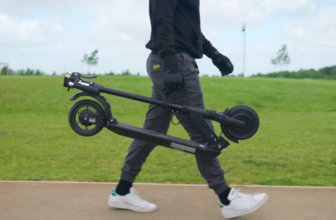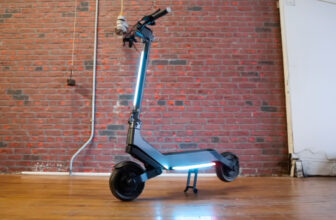How I Test Electric Scooters (Conditions, Equipment & Data)
Every electric scooter that I review undergoes 25 performance tests, 30 design assessments, and 2 post-puchase considerations.
The core foundation that’s built Electric Scooter Insider’s reputation as the premier source for trustworthy, no-nonsense electric scooter reviews is an industry-leading testing process.
After owning, testing, and spending thousands of hours reviewing a wide variety of models, I've acquired a high level of expertise that’s allowed me to put over $109k worth of electric scooters through their paces.
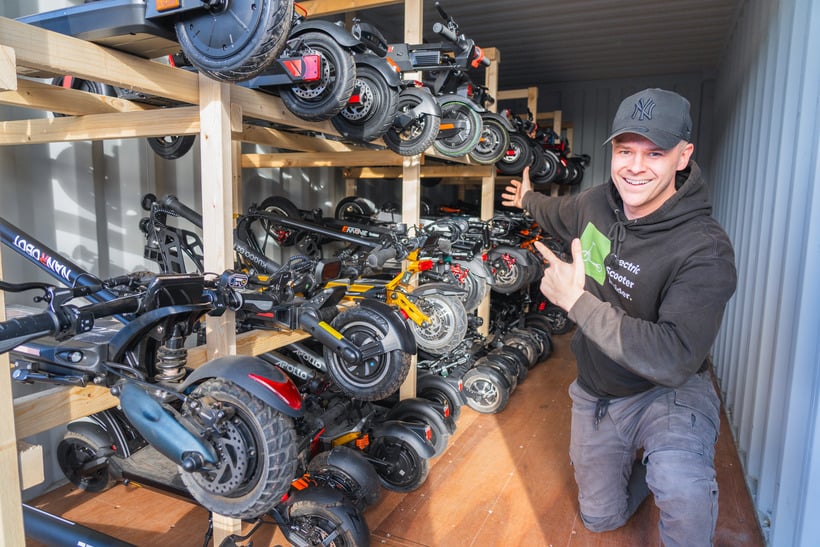
To make sure that each has a fair shot at achieving a place in my coveted list of the best electric scooters, I employ a series of stringent tests and assessments.
Throughout this guide, I’ll show you exactly how I test each scooter with a precise breakdown of the testing conditions, equipment used, and data collected.
See how the tests are standardized using controlled sets of criteria
Learn about the high-precision tools that are used to collect data
Discover the commitments that underpin our reviews
See how I test each scooter's performance
See how I assess the design and features of each scooter
Learn about how I review warranties and customer support
Test Conditions
To establish standardized tests, it’s important to maintain the same test rider. This ensures that each scooter can be tested scientifically, whilst minimizing inconsistencies in performance data.
While some electric scooter review platforms use multiple team members of varying weights and riding styles, in our tests, I am the sole rider.
This allows me to test and assess scooters on a level playing field so that I can accurately compare performance metrics across different models.
To give you oversight, here are my rider stats:
- Name: Josh Frisby
- Height: 6.1 ft
- Weight: 190 lbs (including safety gear)
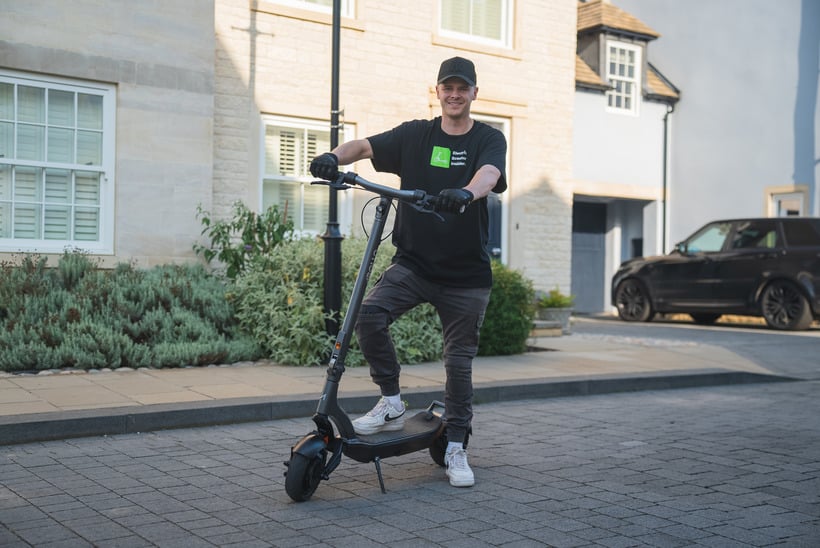
Aside from my rider stats, you can learn more about the test conditions for each performance test (including top speed, acceleration, range, hill climbing, shock absorption, and braking) further down the page.
Test Equipment
While some tests (i.e. ride quality) are inherently based on subjectivity, others are rooted in data.
Our testing processes are constantly being refined to stay at the forefront of the industry. While some of the equipment used to measure performance has evolved in the pursuit of accuracy, other data collection methods have remained the same since they serve their purpose (i.e. using a measuring tape for stopping distances).
Based on the current setup, there are two advanced pieces of equipment that I rely on:
Dragy GPS Performance Box (DRG70)
This is a high-performance GPS data logger that measures speed within 1/100th of a second.
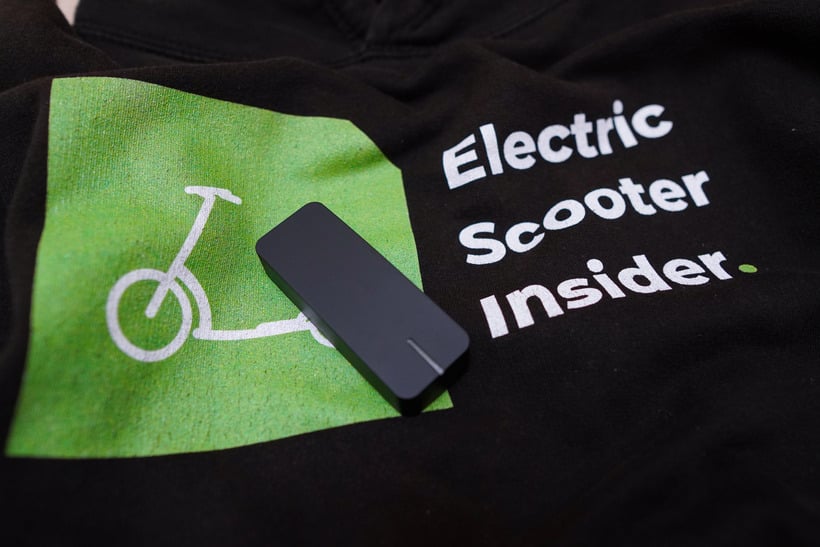
Using the Dragy ensures precise reporting capabilities – a quality further strengthened by its validation criteria. A speed run will only be validated if there are enough satellites and a strong enough signal. The box also takes slope (i.e. grade) data into account. If a significant downward slope is detected, then the run won’t be validated.
What Performance Metrics Do I Measure with the Dragy DRG70 GPS?
- Acceleration intervals (i.e. 0-15 mph, 0-25 mph)
Garmin Edge 130 Plus
This is a compact GPS computer that uses multiple satellite systems to track key performance metrics like range and average speed.
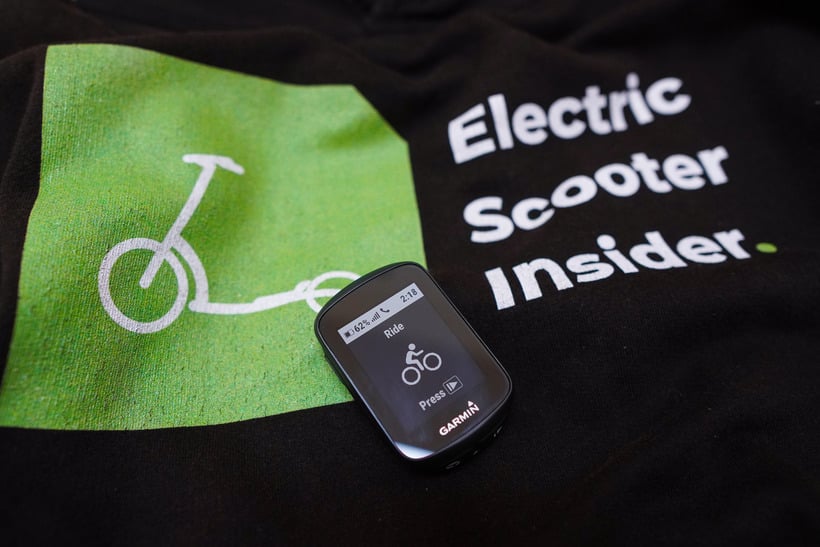
To maintain the utmost accuracy, it pairs GPS tracking with sophisticated positioning systems that include both Galileo and GLONASS. The former is used by European political and military authorities, while the latter is a Russian-operated system for military and civilian use. It’s also equipped with an altimeter to establish elevation. This may sound like overkill, but it ensures the best possible satellite coverage so that data collection is successful.
What Performance Metrics Do I Measure with the Garmin Edge 130 Plus?
- Real-world range (i.e. distance traveled, time elapsed, and average speed)
- Top speed
- New reports in progress: Hill climbs (i.e. grade, elevation, ascent, average speed, and elapsed time)
Commitments to Excellence
All of my reviews and “best” electric scooter lists (i.e. best for speed, off-roading, commuting, etc) share the same commitment to excellence. These are as follows:
Expert Hands-On Testing
Wherever possible, I hands-on test all of the electric scooters that I review. Not only does this include the completion of performance tests, but it also accounts for unboxing the scooters, getting them ready to ride, and familiarizing myself with each one beyond the tests.
I also firmly believe that as an independent sole reviewer, I have owned and tested more electric scooters than anyone else in the industry.
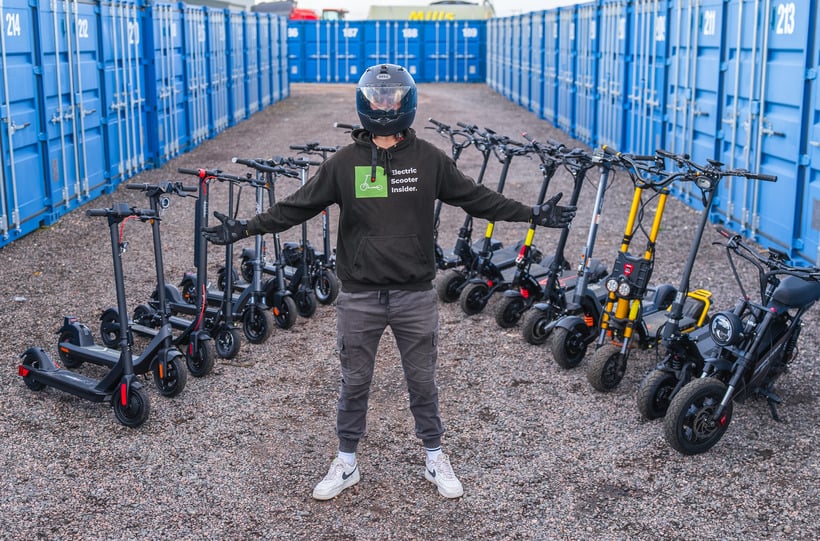
Constant Refinement
One of the core foundations that paves the way for Electric Scooter Insider is our strive for excellence.
In the interest of delivering the most thorough reviews in the industry, our tests are constantly being refined to uncover the areas of performance that matter to you. Whether that means investing in new tech, measuring tools, or making tweaks to how the current tests are completed, you can rely on Electric Scooter Insider as a trustworthy source of reviews.
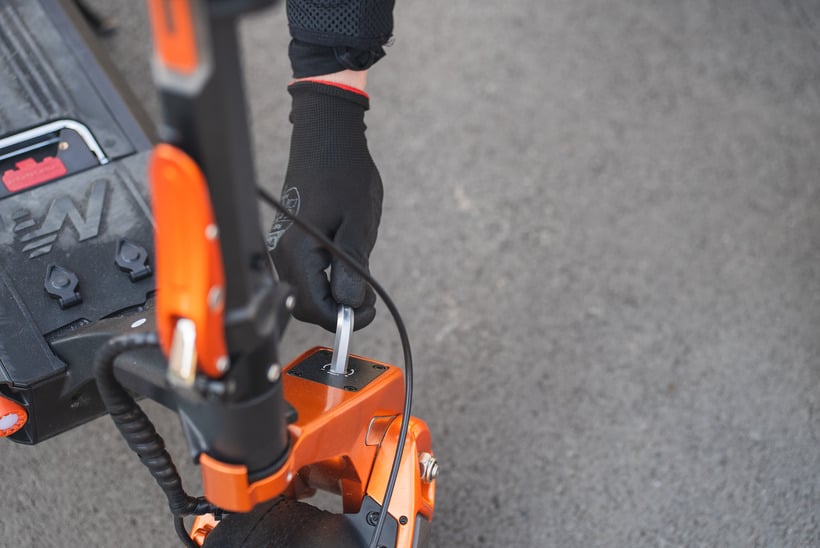
Extensive Research
Designs keep improving, tech is becoming more integrated, and the capabilities of electric scooters are expanding. To keep on top of all that’s new, I'm constantly keeping an eye on the newest releases.
When I can't test a scooter hands-on, I make recommendations based on research, comparative data gleaned from my electric scooter database, and reputable third-party reporting (i.e. industry experts and customers).
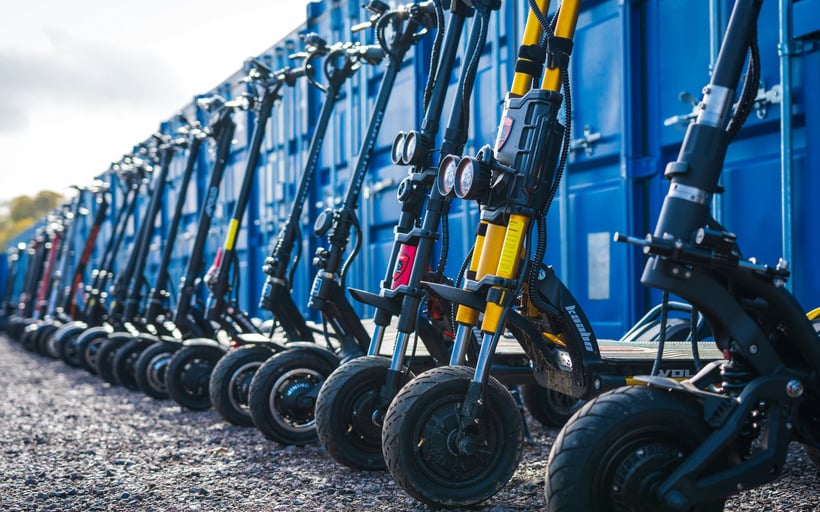
Impartial Advice
I don’t just focus on the good, I also highlight the bad to let you be the judge. By adopting this ethos, I can clearly distinguish where a scooter is better or worse than its competitors. As a result, I can show you alternatives and explain which are the best for certain use cases.
For example, take a look at my review of the Segway Ninebot Air T15. There was a lot of hype surrounding its release as the most compact, lightweight, and energy-efficient electric scooter. But, the truth of the matter is that its fancy cosmetics masked its poor performance. It had style in spades, yet it failed to deliver in the performance department. I scored it a miserable 3 out of 10.
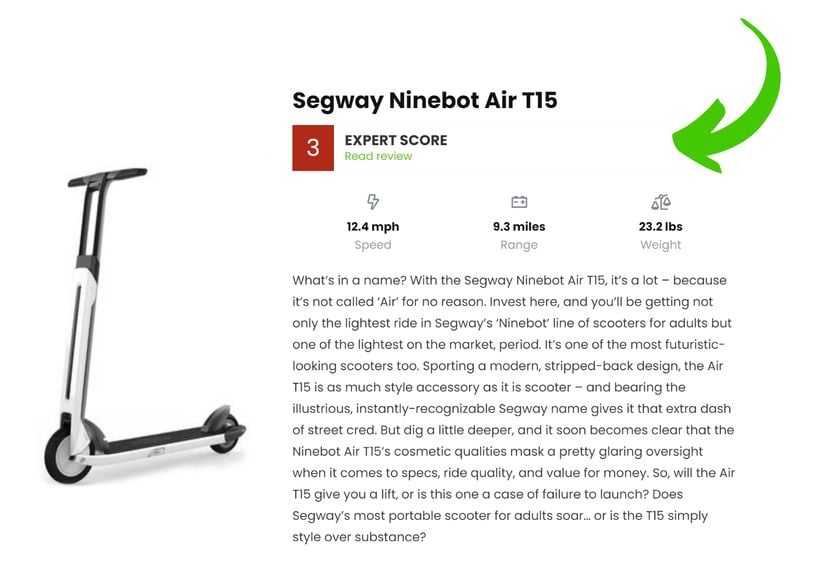
I’m not afraid to put scooters under scrutiny.
Electric Scooter Insider is here to act as a source of integrity for the industry. By doing so, manufacturers, brands, and retailers are forced to continually improve their scooters.
On the flip side, when scooters are good, I’ll put my stamp of approval on them. Take the Apollo City Pro, for example. I crowned it as the creme de la creme of the entire roster of 2023 electric scooters.
Value For Money
As the electric scooter market becomes ever more saturated, I continue to seek out the best models that provide the most bang for your buck. Each scooter is reviewed relative to its price so that I can pick out the top performers for varying budgets.
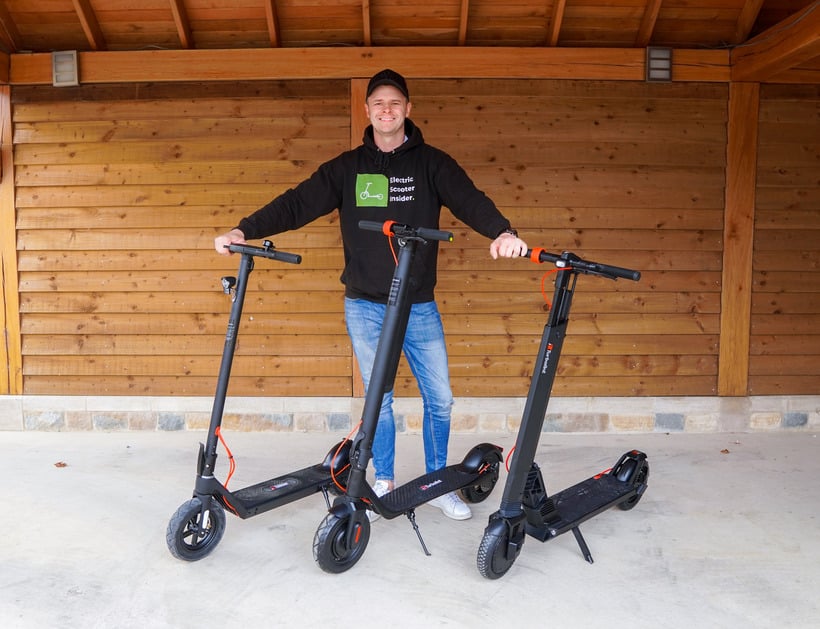
Strict Editorial Policy
My mission is to help you choose the right electric scooter, and I take this very seriously. As a result, I hold both the review process and editorial policy to a very high standard.
Before any content (written or visual) is published, it’s heavily reviewed, audited, and edited.
Whether I’m working on a new buyer guide or an individual scooter review, I always place myself in your shoes to understand what information will be most helpful.
You can learn more about this process in my editorial policy.
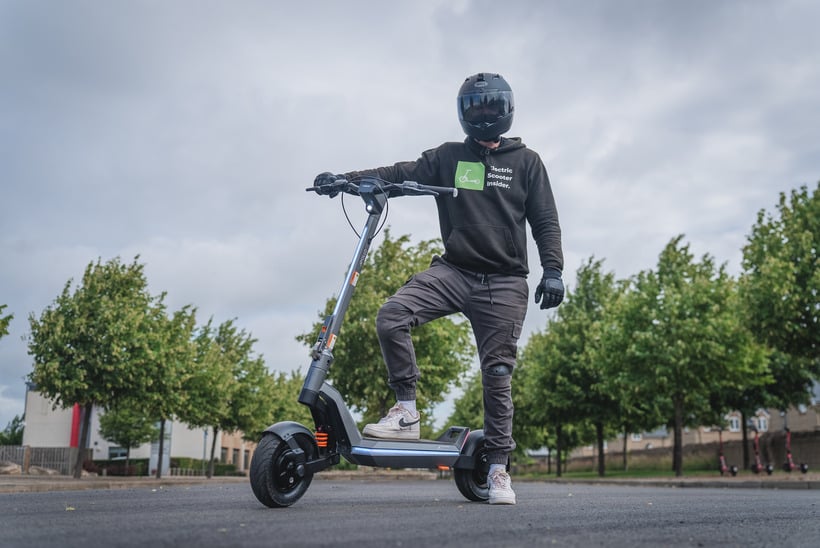
Performance Tests
In total, each scooter is subject to 25 tests across 7 performance categories – including top speed, acceleration, range, hill climbing, braking, shock absorption, and ride quality.
The results from my many performance tests are among the most critical that lay the foundation for comparable data across all of the electric scooters that I review.
To ensure consistency, I have established a series of standardized testing criteria that can be repeated. You can see the criteria for each performance test below.
Top Speed:
Where possible I test the top speed of each electric scooter. I’m typically able to test up to 40 mph. However, for scooters that exceed that, I’m not able to verify true top speed data because I don’t have access to enough runway to safely reach those speeds. This is a common issue among reviewers since testing to this degree would require either access to a controlled automotive test track, or the investment of hundreds of thousands of dollars to build one.
However, I am working on lab tests that will give a close indication of the true top speeds for scooters that exceed 40 mph. This will be based on several measurements and calculations including RPM (revolutions per minute) and wheel diameter. I will disclose more information once the test process has been finalized.
Video: Josh testing the Wolf King GT's top speed
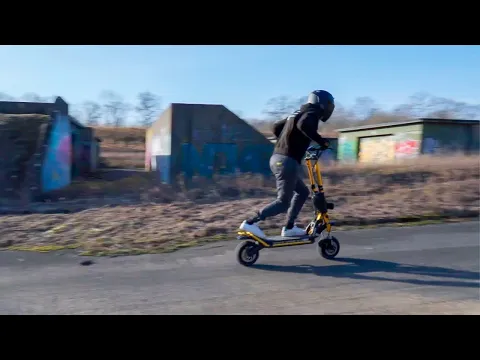
Test Conditions
- Equipment: Dragy GPS Performance Box (DRG70)
- Tester: Josh Frisby (6.1 ft, 190 lbs)
- Environment: Dry, smooth, flat road
- Scooter Settings: Maxed out performance settings, tires inflated to the recommended PSI, and 100% fully charged
- Number of tests: 2x two-way directional runs (4 tests in total)
Data Recorded
- Top speed (mph)
- The results of all the tests are averaged
Additional Reports
- Nominal and peak motor power output
- Handling at speed (i.e. control and stability)
- Top speed results are compared against similarly priced scooters
Acceleration:
While top speed can be considered an ego metric, acceleration is the one that matters. After all, it is responsible for propelling you forward at rates that’ll get your heart thumping and adrenaline pumping.
I currently record acceleration up to 25 mph, however, I’m considering adding more intervals. If this is something that you would like me to report on, please get in touch.
Video: Josh testing the Wolf King GT's acceleration
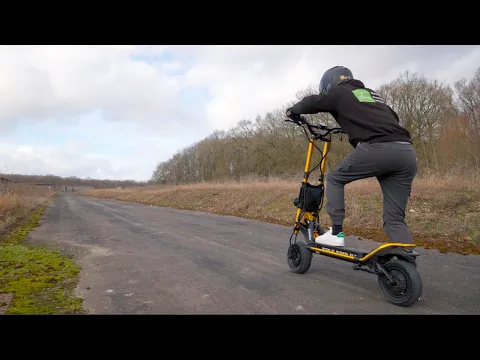
Test Conditions
- Equipment: Dragy GPS Performance Box (DRG70)
- Tester: Josh Frisby (6.1 ft, 190 lbs)
- Environment: Dry, smooth, flat road
- Scooter Settings: Maxed out performance settings, zero-start mode enabled (where possible), tires inflated to the recommended PSI, and 100% fully charged
- Number of tests: 3x two-way directional runs per acceleration interval (6 tests per interval in total)
Data Recorded
- 0-15 mph (seconds)
- 0-25 mph (seconds)
- Additional intervals coming soon (including 20, 30, 35, and 40 mph)
- The results of all the tests per interval are averaged
Additional Reports
- Assessment of wheel spin while accelerating
- Responsiveness of the throttle
- Handling (i.e. control and stability)
- Acceleration times are compared against similarly priced scooters
Range:
Range tests are among the most time-intensive since they can take anywhere from 1 to 3 hours to complete.
Based on my many hands-on tests, as well as the results of third-party reporting, an electric scooter typically achieves 60% of its maximum range when ridden under real-world conditions.
It’s important to note that the results from my tests should be viewed as an indicator of performance. The real-world range can be affected by a variety of different factors including rider weight, terrain, changes in elevation, riding styles, average speeds, outside temperatures, wind resistance, and many other variables.
Video: Josh testing the NAMI Burn-e 2's real-world range
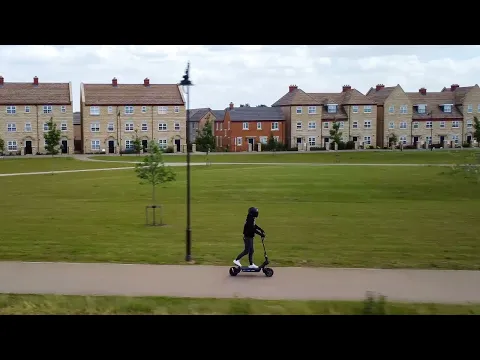
Test Conditions
- Equipment: Garmin Edge 130 Plus
- Tester: Josh Frisby (6.1 ft, 190 lbs)
- Environment: 2.3-mile loop that includes a 131 ft change in elevation from start to finish (the loop is a point-to-point circuit meaning that the scooter is tested across the change in elevation in both directions i.e. uphill and downhill).
- Scooter Settings: Maxed out performance settings, tires inflated to the recommended PSI, and 100% fully charged. Includes periods of fast acceleration, cruising, and multiple stops, though I aim to maintain an average speed of 20-25 mph to reflect real-world riding.
- Number of tests: 1 range test until the battery runs dry
Data Recorded
- Distance traveled / real-world range (miles)
- Time elapsed (hours, minutes, and seconds)
- Average speed (mph)
Additional Reports
- Notes are taken on the scooter’s ride quality
- Maximum and real-world range figures are compared against similarly priced scooters
Hill Climbing:
Important: The current test methodology is soon to be replaced with a newly refined process (more details below).
Based on my independent testing, optimal incline performance is often 60% of the maximum incline rate.
While the results from the current tests detail a scooter’s ability to scale different types of inclines, there’s room for improvement to introduce comparative hill climbing data. To address this, I’ve formulated a new test that’ll use the Garmin Edge 130 Plus to measure the time and average speed that each scooter takes to scale the same incline.
To ensure consistency, all tests will be performed on a stretch of road that measures 1,584 ft and includes a 112 ft rise in elevation. From start to finish, there's an average incline rate of 7.07% (4.04 degrees), with sections reaching as high as 11.29% (6.44 degrees). This is the longest and most challenging hill climb test in the industry.
Video: Josh testing the hill climbing performance of the Hiboy S2 Pro and INOKIM OxO
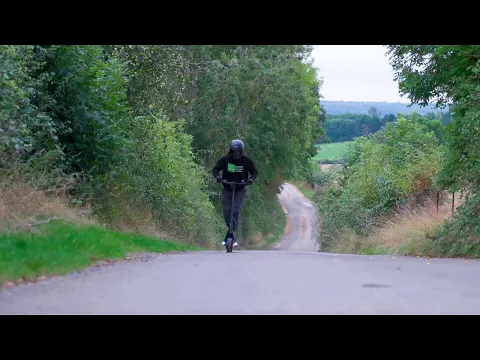
Test Conditions
- Equipment: Angle Meter
- Tester: Josh Frisby (6.1 ft, 190 lbs)
- Environment: Hilly test course
- Scooter Settings: Maxed out performance settings, tires inflated to the recommended PSI, and 100% fully charged.
- Number of tests: An ongoing reporting process that combines experiences gathered from the range test and general riding.
Data Recorded
- Optimal incline (degrees)
Additional Reports
- The types of slopes that it can scale (i.e. gentle, moderate, or steep)
- Peak motor power output and battery watt-hours, since these determine the effectiveness of a scooter’s ability to climb hills
Further Information:
Electric Scooters For Climbing Hills: Breeze Up the Steepest of Inclines
Braking:
The distance that it takes a scooter to stop is a vitally important metric that you should pay attention to. Based on hundreds of braking tests, stopping distances can be interpreted as follows: Excellent (less than 2.5 meters), Very Good (2.5 – 3.0 meters), Good (3.0 – 3.5 meters), Fair (3.5 – 4.0 meters), and Poor (more than 4.0 meters).
Video: Josh testing the braking performance of the NIU KQi3 Pro
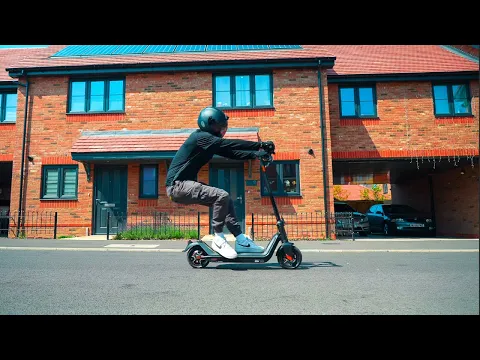
Test Conditions
- Equipment: Measuring tape
- Tester: Josh Frisby (6.1 ft, 190 lbs)
- Environment: Dry, smooth, flat road
- Scooter Settings: If the scooter uses electronic or regenerative braking systems they are maxed out to the strongest setting. The scooter is ridden at 15 mph before applying all the brakes.
- Number of tests: 5x controlled stopping distance tests (i.e. not losing control as a result of skidding)
Data Recorded
- Stopping distance from 15 mph (meters)
- Measurements are taken from the beginning of the measuring tape to the front wheel of the scooter
- The results of all the tests are averaged
Additional Reports
- The type of brakes (i.e. mechanical and electronic)
- The position of the brakes (i.e. front, rear, or both)
- Whether the brakes can be adjusted to change the stopping distance
- How well-calibrated and responsive the brake levers are
- The strength of the electronic braking system (if appropriate)
Shock-Absorption:
Measuring the shock-absorbing profile of an electric scooter is subjective. However, with years of experience where I’ve tested all kinds of scooters, I am in a unique position to score each appropriately. In all of my time testing, only one scooter has achieved a perfect 10/10 score – the NAMI Burn-e 2.
Video: Josh testing the NAMI Burn-e 2's shock absorption
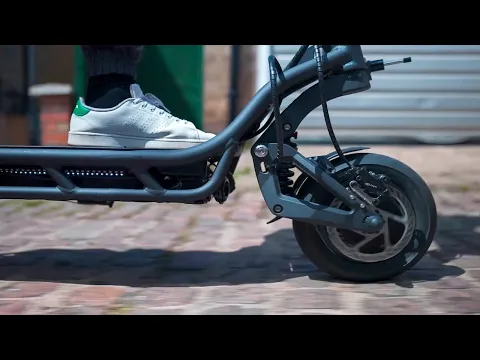
Test Conditions
- Equipment: None
- Tester: Josh Frisby (6.1 ft, 190 lbs)
- Environment: Electric scooters destined for street use are tested on two types of roads: smooth and pot-holed. Off-road models are tested across dirt tracks and forest trails.
- Scooter Settings: Tires are inflated to the recommended PSI, and if the scooter has a suspension system, checks will be made to ensure that it’s operating as intended.
- Number of tests: An ongoing reporting process that combines experiences gathered from the range test and general riding.
Data Recorded
- Using a scale of 1 to 10 – where 1 is extremely stiff and 10 is extremely soft – I classify how well a scooter absorbs shocks.
Additional Reports
- The type of suspension (i.e. springs, rubber, hydraulics)
- Amount of travel that the suspension provides
- The balance of shock absorption across the front and rear of the scooter
- Rebound and compression rates (i.e. is the suspension controlled or bouncy)
- Whether the suspension can be adjusted and its impact on performance (including pre-load)
- Assessing if the suspension can bottom out (i.e. springs clanking together when being compressed)
Ride Quality:
Ride quality is possibly the most important metric. It’s the key indicator of whether an electric scooter is enjoyable to ride. With this in mind, I suggest placing more weight on ride quality in your decision-making process, even if it means reducing speed and range stats to accommodate your budget.
Video: Josh testing the NAMI Klima's ride quality

Test Conditions
- Equipment: None
- Tester: Josh Frisby (6.1 ft, 190 lbs)
- Environment: Electric scooters destined for street use are tested on two types of roads: smooth and pot-holed. Off-road models are tested across dirt tracks and forest trails.
- Scooter Settings: No particular settings are required for this test.
- Number of tests: An ongoing reporting process that combines experiences gathered from the range test and general riding.
Data Recorded
- A subjective opinion on how the scooter feels to ride
- This is an all-encompassing measurement that takes into account all aspects of the scooter’s design and performance. Here, I focus on handling, comfort, and power delivery.
Additional Reports
- How the geometry and dimensions of a scooter aid its stability and control (i.e. rake angle, handlebar width, deck-to-handlebar height, deck size, kickplate angle, weight distribution, etc)
- Ability to customize the scooter to your preferences (i.e. create different riding modes, adjust the performance settings, alter the compression and rebound rates of the suspension, etc)
- How well the scooter responds to different riding inputs (i.e. is the throttle smooth or jerky, can you carve from side to side, can you take corners at speed, are you able to transition seamlessly from street to off-road terrain, etc)
Design Tests
While the performance metrics serve as an integral part of the testing process, I also thoroughly assess the design and features of each scooter.
In total, each scooter is subject to 30 assessments across 10 design categories – including the cockpit, frame, deck, tires, portability, suitability, lights, extra features, dimensions, and build quality.
Cockpit:
Handlebar Width
Based on my many years of testing I’ve found a direct correlation between handlebar width and control (the wider the bars, the greater the control). Importantly, my assessment of width is made in relation to the scooter’s power. Typically, those with less power have narrower bars, while those that are faster need broader dimensions to ensure sufficient control.
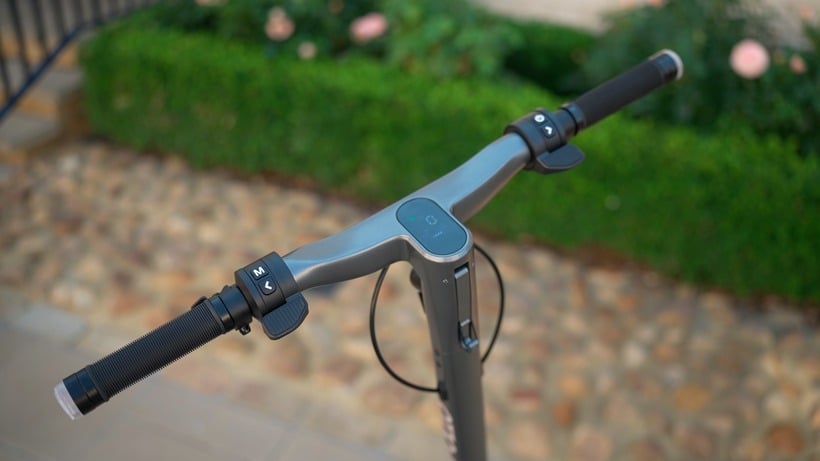
Ergonomics
This covers everything from the shape of handlebars to the throttle, buttons, and controls. The main thing that I’m testing here is ease of use and comfortability (i.e. does the throttle have a smooth-actuating motion, are the buttons responsive and clicky, and are the controls within easy reach).
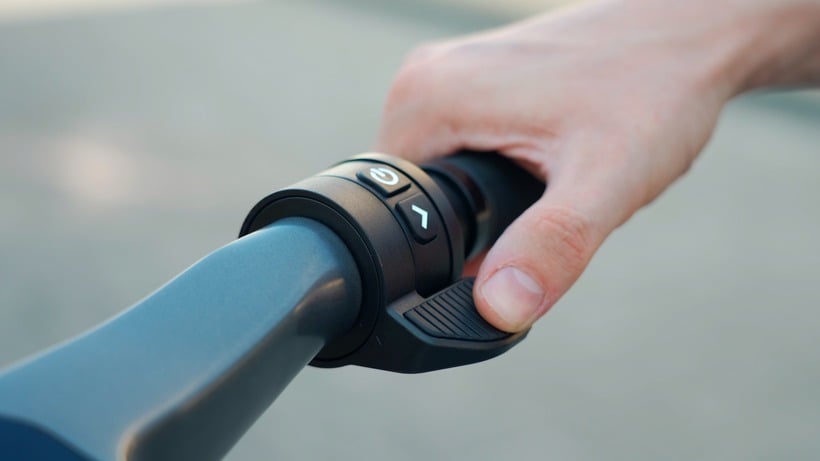
Display Visibility
Displays come in many shapes and sizes and can be packed with information, but they need to be visible to be effective. Here, I test the brightness of each display to assess whether they are visible under direct sunlight (i.e. do they get washed out or remain clear).
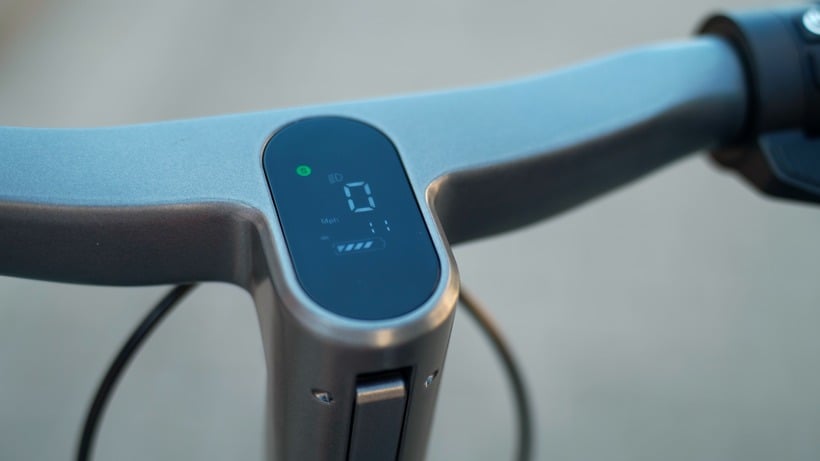
Frame:
Design
The overall design of each scooter is assessed for its aesthetic value (i.e. does it have a cookie-cutter design or does it sport any standout features that make it unique).
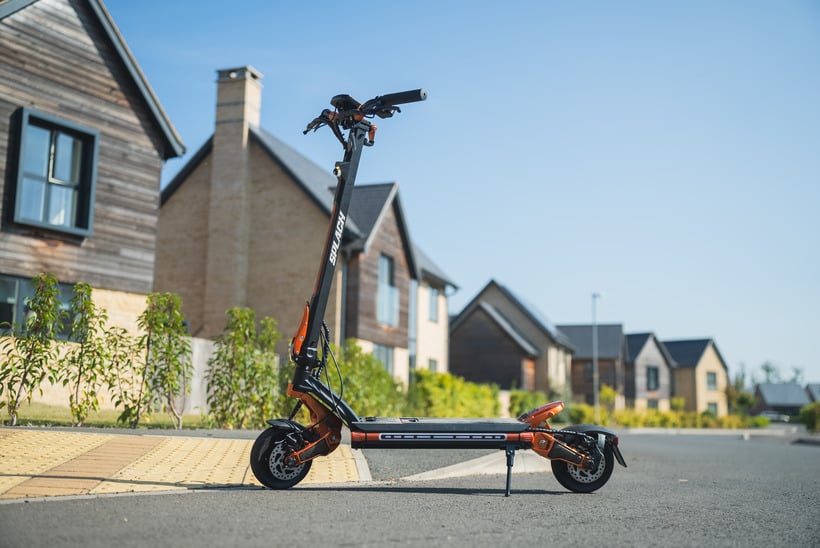
Geometry
How the frame has been constructed plays a huge role in the performance of a scooter, particularly in the ride quality department.
Here, I measure the rake angle to assess the scooter's potential for stability. This is the angle of the steering column in relation to a vertical axis through the front axle. The smaller the angle, the less effort required to turn the handlebars, but the less stable it’ll be. Conversely, a larger rake angle requires more effort to turn but makes the scooter more stable at higher speeds. Scooters that hit the sweet spot between the two can maintain both stability and nimbleness.
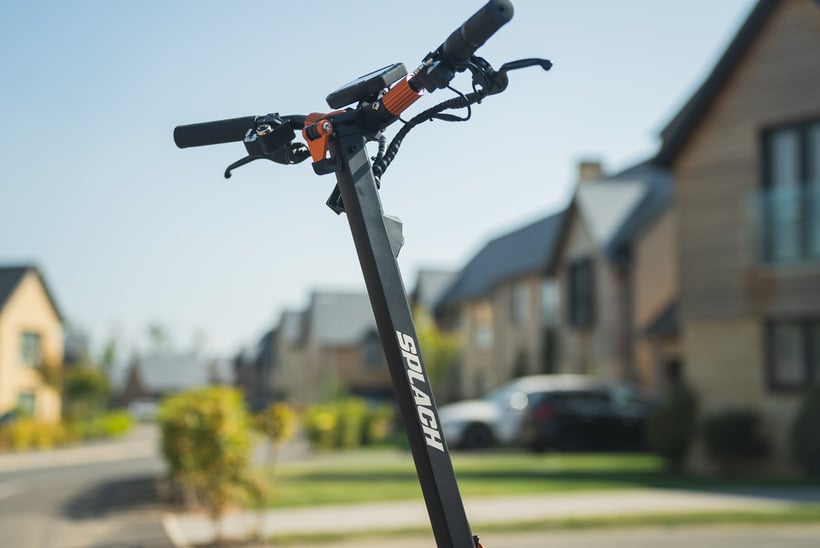
Weight Distribution
Similar to geometry, weight distribution can affect a scooter's handling. As a result, I make sure to get a good feeling of the scooter before giving my verdict on the quality of its ride.
Based on my tests, the top performers are those that distribute their weight evenly across their frame. To make this assessment, I search for imbalances (i.e. a bottom-heavy design that causes the steering column to be underweight and twitchy). If I can’t find any, then the scooter scores highly.
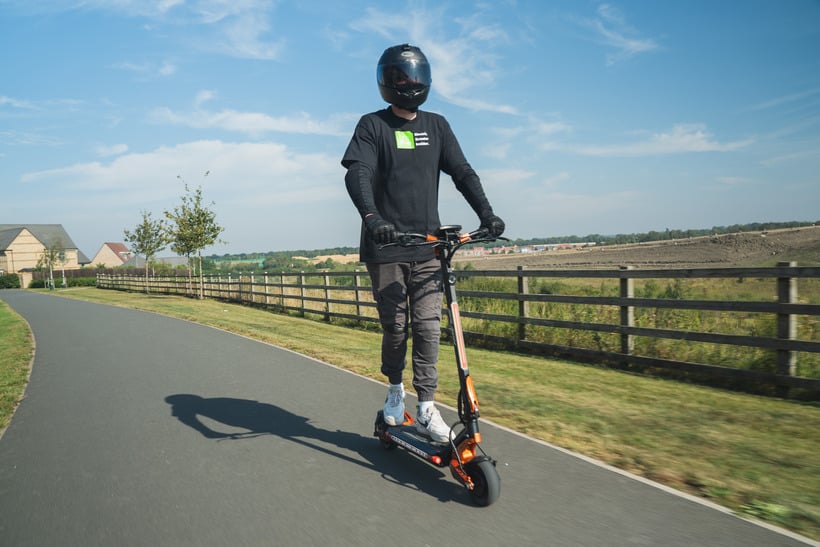
Deck:
Deck Size
Most manufacturers publish dimensions detailing the length and width of the scooter’s deck. However, these can occasionally be incorrect and don’t paint the full picture. They don’t take into account the available space for your feet, but rather just present generic blueprint dimensions. For instance, if there are charge ports on the deck that take up a couple of inches of space, the manufacturer won’t report this.
As a result, I measure the size of each scooter’s deck to accurately assess the amount of space that’s usable.
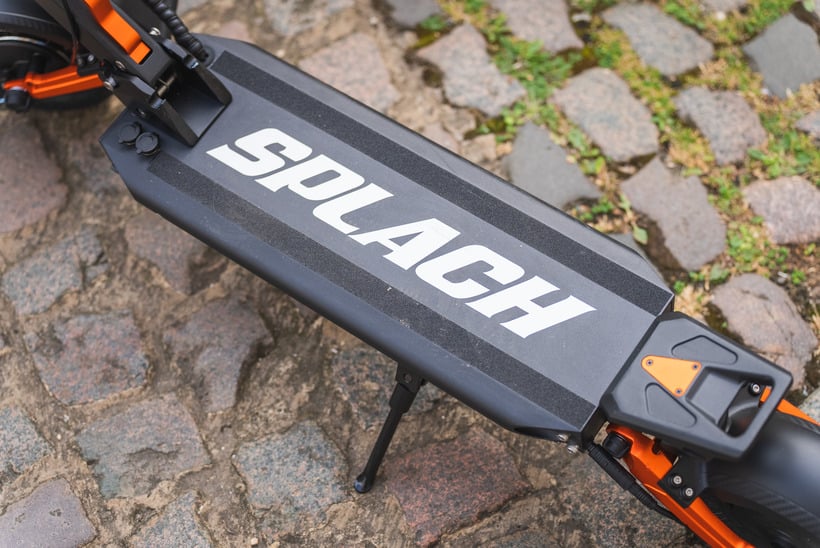
Kickplate Size and Angle
In addition to the deck, I measure the length of each scooter’s kickplate since it serves as a useful place to rest your back foot.
Building on this, I take readings of the angle at which the kickplate is positioned. Kickplate angles that range from 0-30 degrees provide a comfortable foundation for your foot to rest on, while those that exceed 30 degrees can feel unnatural.
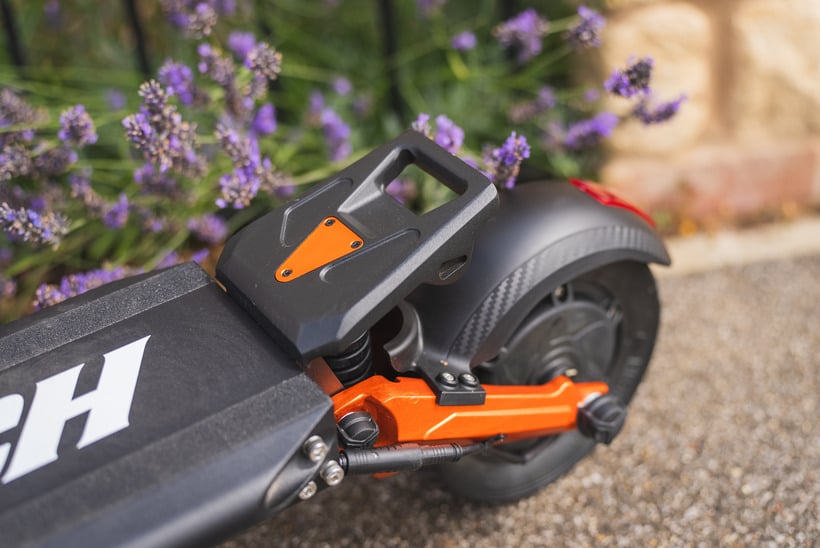
Ground Clearance
By measuring the clearance between the ground and the bottom of the scooter, I’m able to make recommendations on how you can ride it (i.e. rolling over curbs, forest tracks, etc).
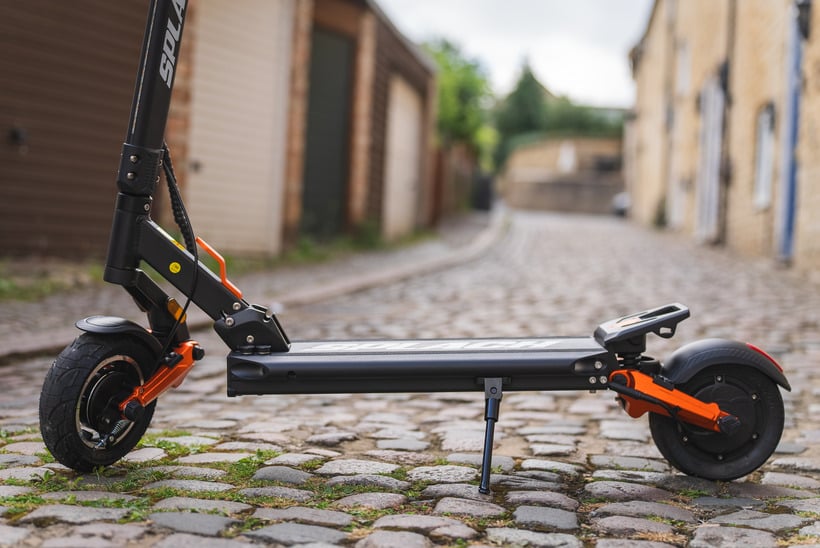
Grip
While the size of the deck and kickplate influences comfort, the amount of grip that you have influences handling. Here, I make a subjective assessment of the deck’s adhesive qualities.
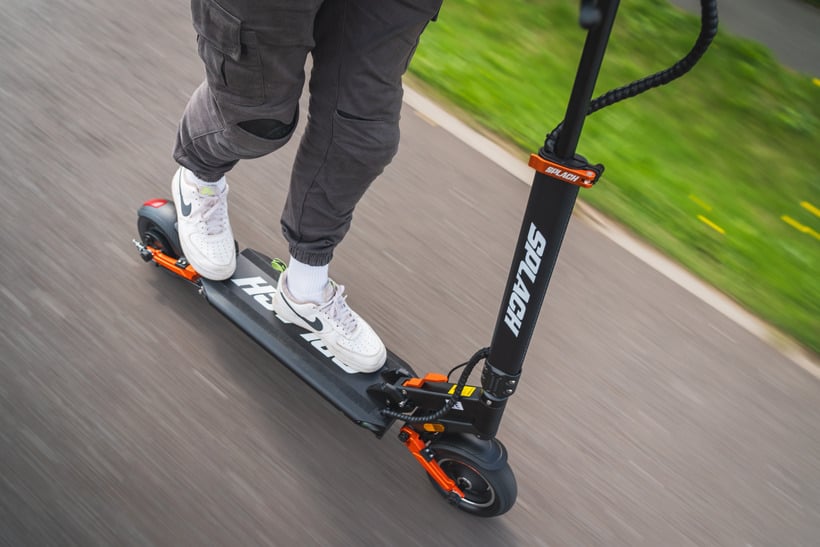
Tires:
Size, Type & Profile
Aside from reporting on the height, width, and shock absorption of different types of tires (i.e. inner-tube, tubeless, self-healing, solid, foam, and honeycomb), I also assess shape and profile.
Key to my report is how responsive, nimble, and agile the tires are. In particular, assessments are made on how the tires perform when accelerating, braking, and cornering.
Those that perform best are typically air-filled (tubeless or self-healing) and have a rounded front-on profile. This is because they are pliable and maintain a large contact patch with the ground at all times.
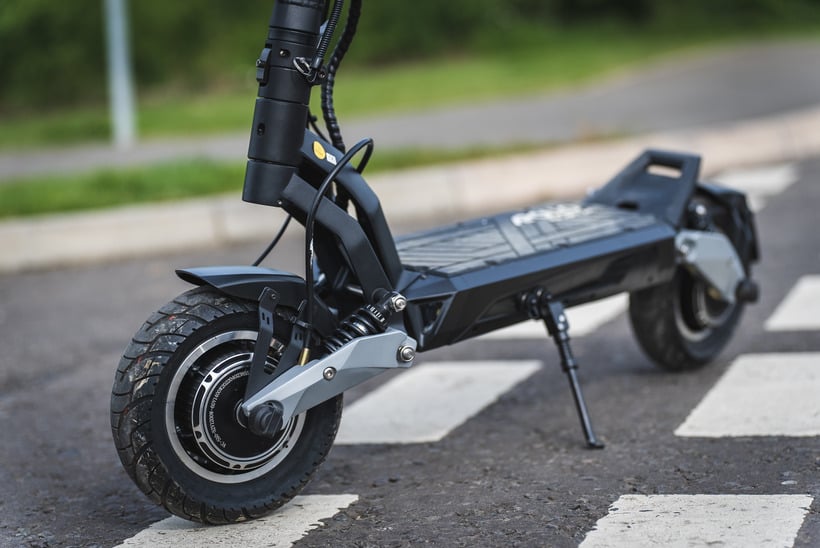
Tread & Traction
In addition to the tests above, tire tread is assessed on its ability to maintain traction.
For street-grade scooters, traction is tested on smooth roads, as well as pot-holed streets. Off-road models, on the other hand, are tested on loose, unpredictable surfaces, including dirt tracks and forest trails.
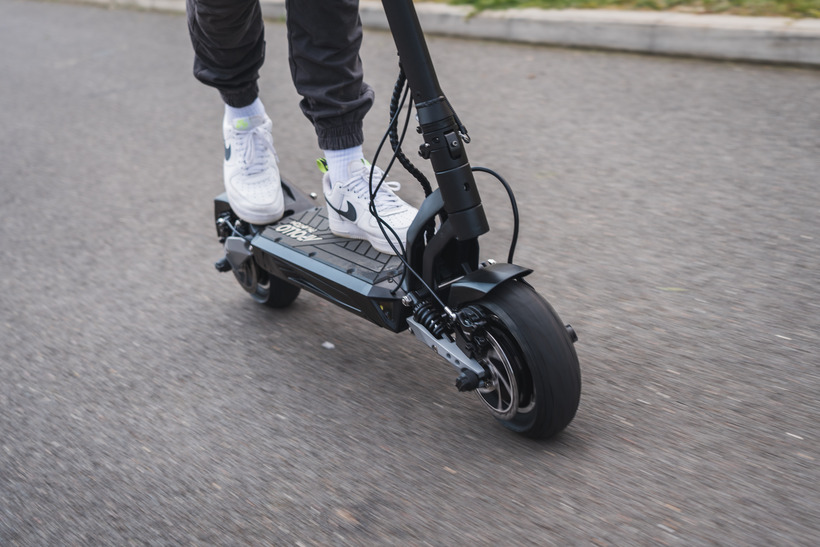
Portability:
Folding Functions
Electric scooters are inherently designed to be practical transport solutions, and as a result, I test each model’s folding mechanisms (including the main mechanism that allows the stem to collapse, foldable handlebars, and telescopic stems).
During the tests, I report on how easy the mechanisms are to use, the rigidity of them, and whether the scooter can be picked up and carried.
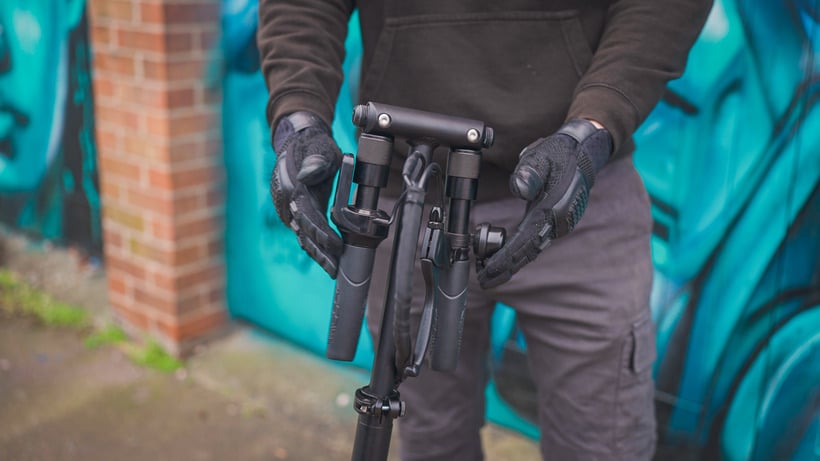
Weight
The weight of an electric scooter doesn’t typically differ much from the manufacturer's specifications, and so these values are reported on. I do, however, use my independently gathered performance test data to compare power-to-weight ratios side-by-side.
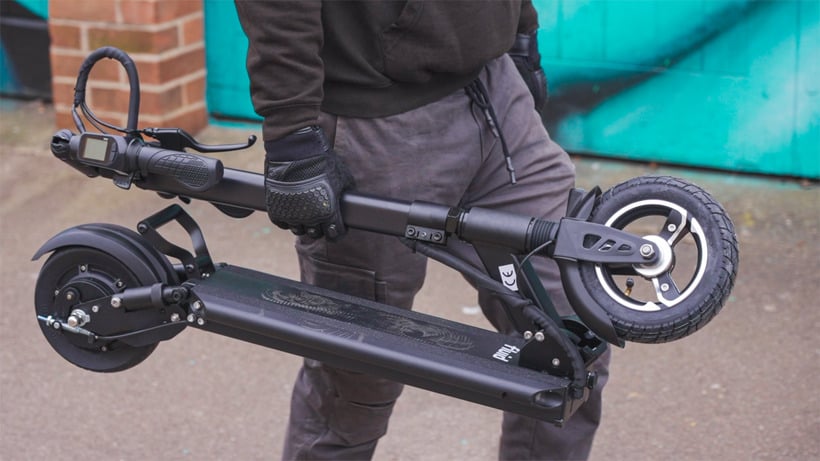
Folded Dimensions
Where necessary, I review how compact each scooter is by reporting on its folded length, width, and height.
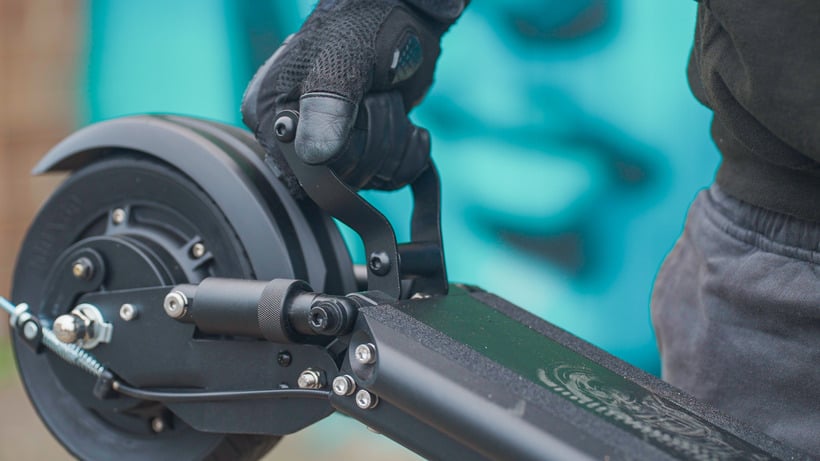
Suitability:
Maximum and Optimal Load Capacity
All electric scooters come with a maximum load-bearing capacity. However, what isn’t as widely known is that the vast majority of scooters are tested with just a 165-175 lb rider.
So, even if you fall within the manufacturer-quoted load capacity, a heavy rider may not achieve the same performance stats as a lighter rider.
To account for this, I report on optimal load-bearing capacity which assesses top performance based on rider weight. This typically equates to 85% of the maximum load.
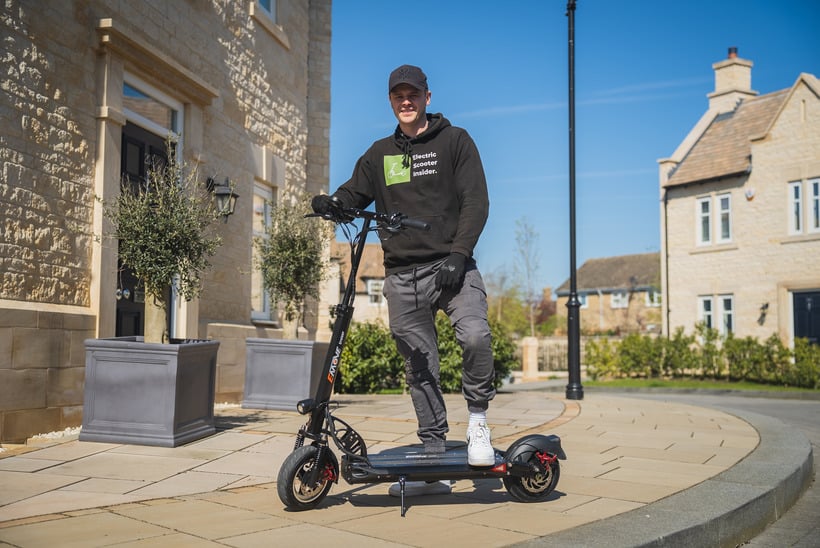
Deck-to-Handlebar Height
The distance from the handlebars to the deck is key to your comfort, yet manufacturers fail to report on it. If it’s too short, you can be forced to crouch over and have less control.
To address this, I measure the distance between the two and provide recommendations as to who the scooter is suitable for (i.e. those up to a specific height).
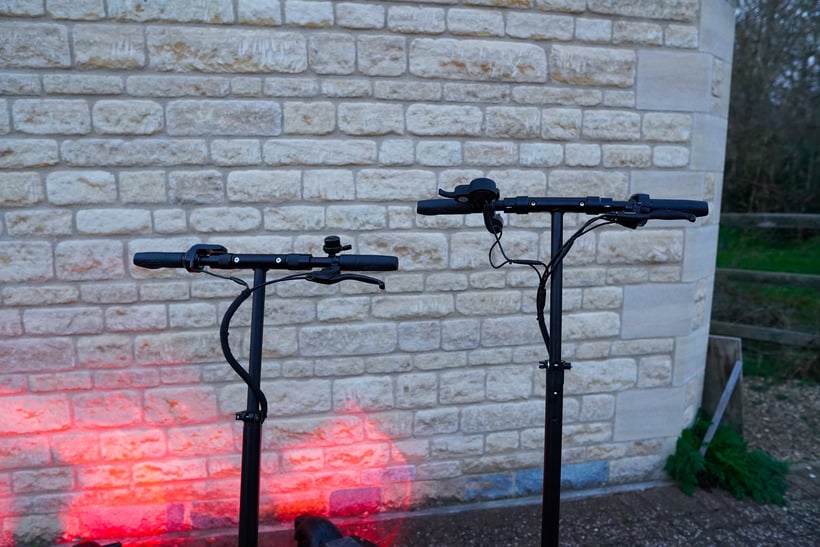
Lights:
Lumens
Lumens (lm) are units of measurement that denote how bright a light is. The more lumens, the brighter the light.
To measure how bright a scooter’s headlight is, I employ two measurements. The first is an objective comparison of its lumen count against similarly priced competitors. The second is a subjective assessment where I test each scooter at night.
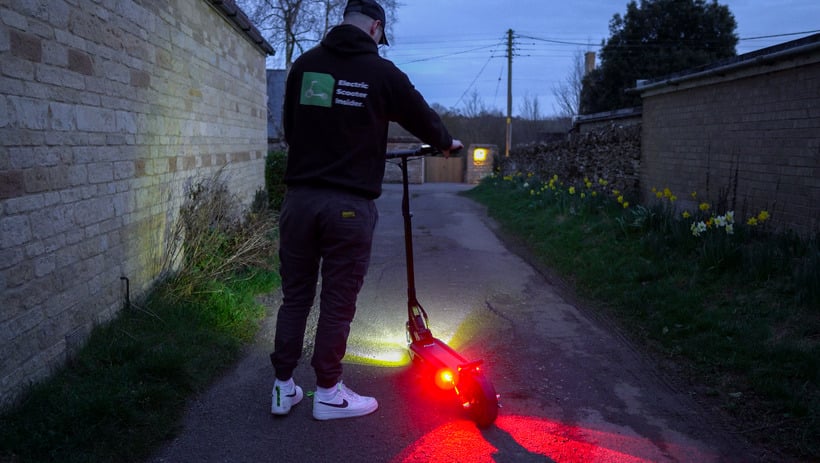
Beam Distance and Angle
While there’s no magic number, I will report on how well the headlight illuminates the way forward. Here, I pay special attention to the shape, direction, and size of the beam.
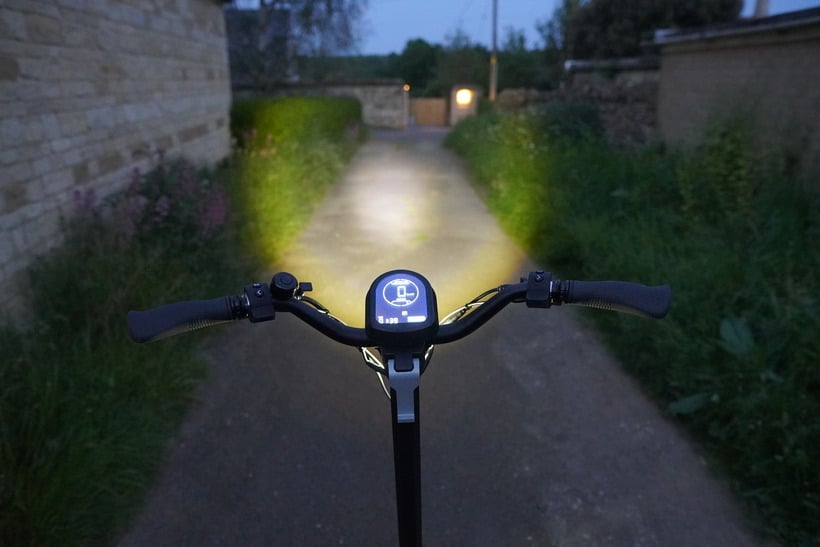
Safety & Visibility
Alongside the headlight tests, I also make sure to report on the visibility of the scooter to other road users.
This includes an assessment of the taillights, turn signals, and any other LEDs (i.e. stem and deck strip lights). These are tested during the night and day to accurately review their effectiveness.
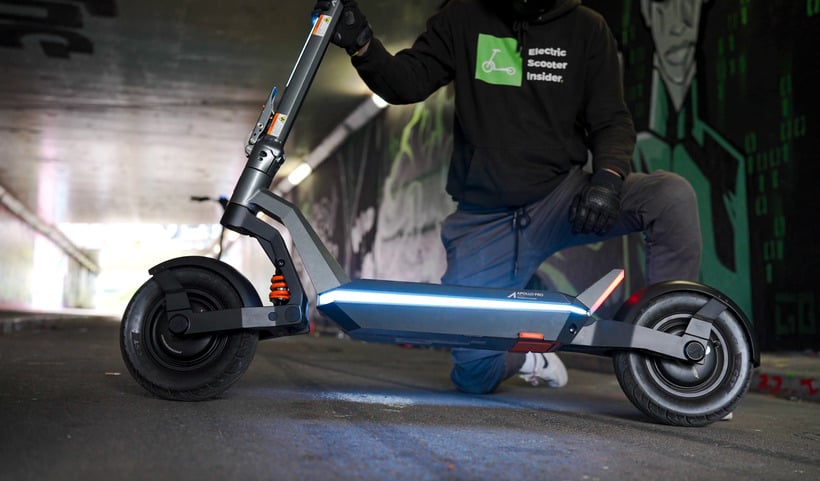
Extra Features:
Throughout the review process, all of the core components and features that make up a scooter are thoroughly reviewed against a preset list of criteria. However, any features that fall outside of this scope (i.e. mobile apps, seat attachments, anti-theft devices, etc) are tested (where possible) as ad-hoc evaluations per scooter. This method of testing has been adopted because additional features can vary widely in their designs and functions.
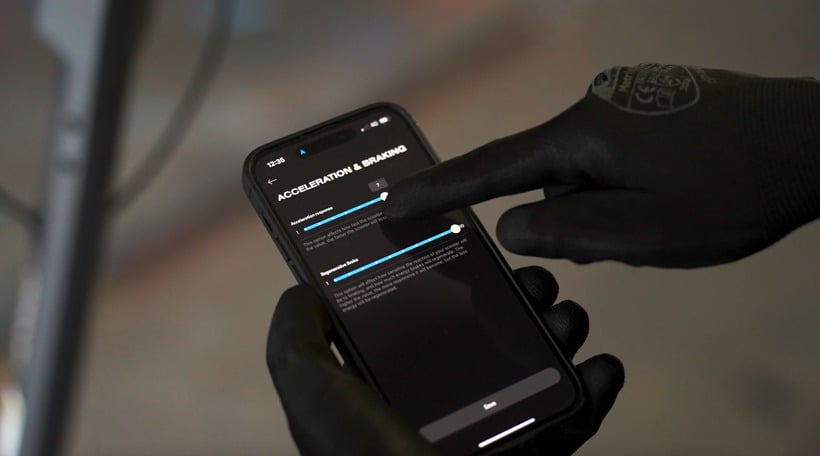
Dimensions:
Although manufacturers provide basic dimensions, I’ve found that they can be littered with errors. They also don’t include some of the most important measurements that can determine the suitability of an electric scooter for different riders.
Consequently, I conduct precise measurements across the following:
- Handlebar width (inches) – an indicator of control and handling
- Deck-to-handlebar height (inches) – an indicator of suitability for riders of different heights
- Usable deck space (inches) – an indicator of comfort
- Kickplate size (inches) – an indicator of comfort
- Kickplate angle (degrees) – an indicator of comfort
- Ground clearance (inches) – an indicator of how the scooter can be ridden
- Rake angle (degrees) – an indicator of stability and handling
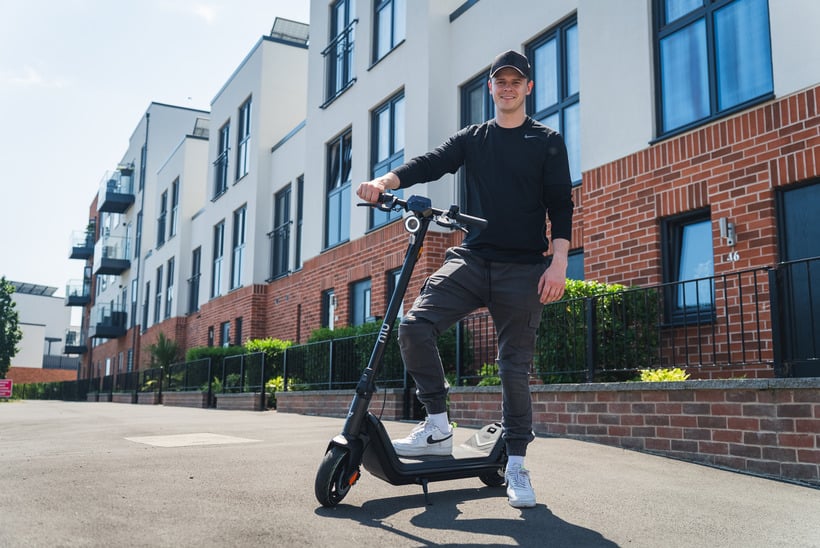
Build Quality:
Craftsmanship
The craftsmanship of each scooter is put under scrutiny.
To do this, I report on the materials used (i.e. the materials for the frame and consumables), how the parts have been designed (i.e. are they OEM or proprietary, forged or cast, or manufactured using one-piece CNC or welded together), and how they have been assembled (i.e. does each part fit seamlessly with the next to achieve a desired outcome or does it have a clunky Frankenstein feel).
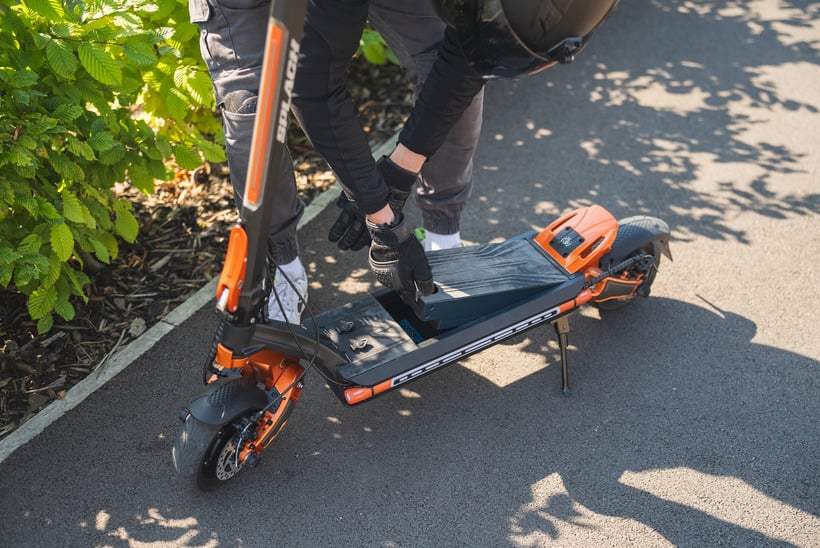
Durability & Reliability
Aside from putting each scooter through my rigorous testing process that, by its nature, allows for the assessment of durability, I also report on key indicators of reliability – including water-resistance ratings, battery management systems, and the rigidity of folding joints to assess stem wobble.
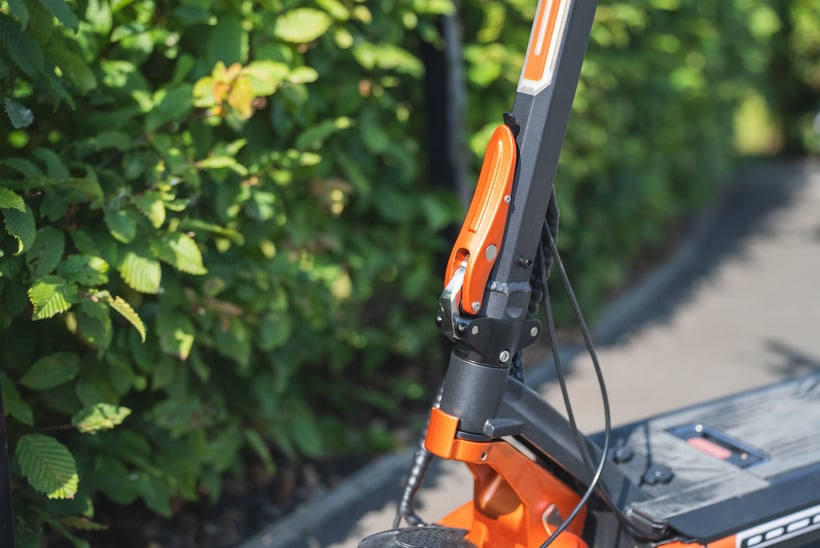
Post-Purchase Tests
Reviewing a scooter based on its performance and design is important, but so is the assessment of what happens after you've purchased it.
In total, each scooter is subject to 2 assessments across 2 post-purchase considerations – including warranties and customer support.
Warranty:
In the interest of producing reviews that are substantial, complete, and comprehensive, I make sure to assess each scooter’s warranty policy, detailing its duration, items that are covered, items that are not covered, and any costs associated with claims (i.e. shipping and labor fees).
I also detail the differences in warranties among various brands and retailers to give an objective assessment of how they stack up against each other.
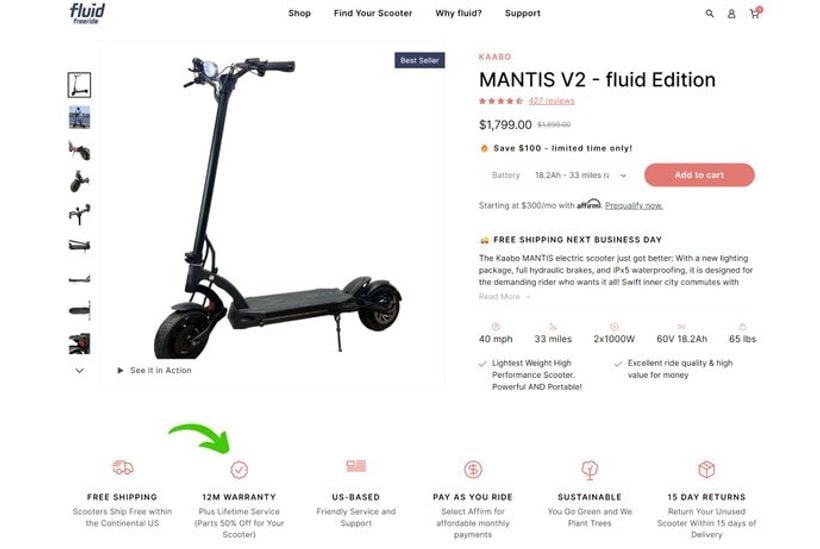
Customer Support:
Where possible, I report on the services that brands and retailers provide after making a purchase.
Here, I assess each based on how easy they are to contact (i.e. live chat, phone, and email) and what support structures they have in place for troubleshooting and ongoing assistance (i.e. knowledge hubs, help desks, access to service centers, and lifetime commitments that entitle you to discounted repairs post-warranty).





